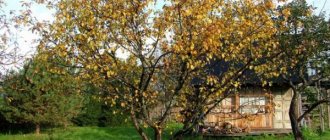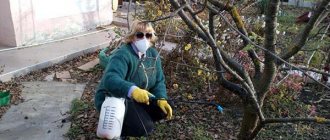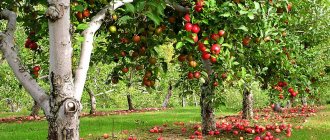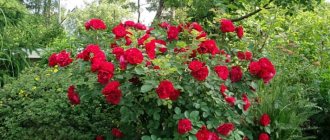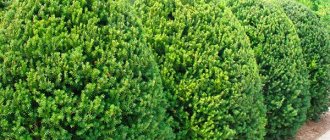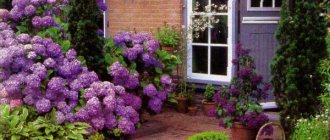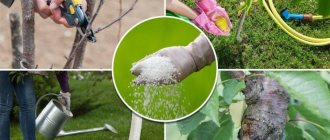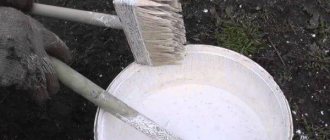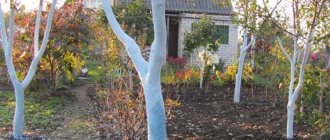Every summer resident wants to have a beautiful and healthy garden near their house or to landscape the area with unusual coniferous trees. Many gardeners wonder: what trees are planted in the fall?
A significant portion of trees and shrubs that have a closed root system can be planted in spring and late autumn, until November. Perhaps autumn is the best time to plant garden or fruit trees, as well as berry bushes, in your dacha. The exception is during leaf fall.
General information on how to choose the right time to plant
Autumn, along with early spring, is rightfully considered optimal for planting seedlings of fruit trees and most berry bushes at the dacha. However, it is worth remembering to follow some rules and take into account the characteristics of different types of plants. So, for example, stone fruit trees in the garden should be planted in early spring, and seedlings of fruit trees such as apple trees or pears are best planted in late autumn at a positive average daily temperature.
In addition to fruit seedlings, many people plant coniferous trees in their dachas near their houses, which have become noticeably popular recently. It should be remembered that for planting coniferous seedlings, as well as for fruit and berry seedlings, there are certain rules and the best time when the plant is guaranteed to take root and grow strong.
Autumn planting in garden plots has a significant number of advantages.
- Availability of a wider selection of planting material for almost any seedlings.
- Plants planted in soil that has warmed up over the summer do not require special care. The main care consists of high-quality watering when planting seedlings. Further irrigation of the root system is carried out without human intervention - with autumn rains.
- Trees planted in winter that have any injuries that could have been caused during transportation or planting will easily recover before the spring warmth.
- It is when planting in the fall that faster regeneration occurs and suction roots grow.
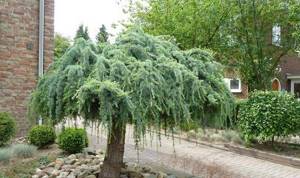
In addition, gardeners who plant seedlings in the autumn free up a significant amount of time needed for active and labor-intensive work in the spring.
Advice from experienced gardeners
In the conditions of the middle zone , the Urals and Siberia, for autumn planting it is best to choose zoned and, if necessary, winter-hardy varieties that are acclimatized and quickly take root. Thus, fruit trees of Siberian and Ural selection - pear and apple trees, rowan, mulberry and cherry plum - tolerate planting in autumn quite well.
for gardeners in the southern regions to plant trees in the fall. In these parts, autumn is long, warm, with periodic rains, which is “just right” for seedlings. But spring here can too quickly give way to hot summer.
Seedlings that were dug up ahead of time (before natural leaf fall) most often have immature shoots and almost always freeze slightly.
If you bought a “beautiful tree” with leaves for planting, you risk getting not only an immature, but also an overdried seedling , because the main loss of moisture occurs through the leaf plate.
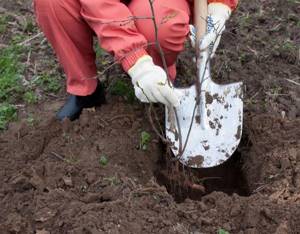
In the south, autumn planting of trees and shrubs is preferable
The main thing is to remember: nature will lend its hands to any of its offspring, and we must try to deliver healthy, mature seedlings with a good root system to the nursery at the most favorable time. Then the young tree will not have to sit on “sick leave” for years and receive “disability” by the time it reaches adulthood. If everything is done correctly, no matter what season we plant - autumn, summer or spring - the tree will respond with cheerful growth, excellent development and a rich harvest.
Types of fruit trees in Ukraine
There is a huge list of fruit seedlings that can be planted near your home in the fall. The most commonly planted garden trees are apple, cherry and pear. You can safely plant cherry plum, mulberry and rowan during this period. A significant portion of varietal plums tolerate autumn planting well.
Experienced gardeners have long noted that garden trees can be planted until late autumn. Fruit trees planted in the fall produce a larger and juicier harvest.
What trees and shrubs are best to plant in the fall and why?
Every year gardeners ask themselves the question: when is the best time to plant fruit trees and berry bushes?
, autumn or spring. Each season has its own advantages and disadvantages.
Let's take a closer look at why it is better to plant trees in the fall.
when and how to plant on your summer cottage.
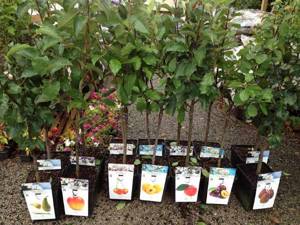
Each plant has its own favorable time for transplanting and planting in a new place.
Let's figure out which fruit trees can be planted in the fall
and why.
Types of ornamental trees that can be planted in November
Planting coniferous trees in the fall can be more effective than in the spring. Planting a coniferous seedling in soil that has warmed up over the summer will allow the plant to better adapt to its permanent location. You can try to plant conifers near the house in the spring, but in this case the soil will not yet be warm enough.
In the fall, you can plant almost any coniferous trees on the site. Thuja and Canadian hemlock take root best. It is not uncommon to grow juniper, pine, larch, fir and spruce near the house, which winter well after autumn acclimatization.
Many summer residents plant deciduous trees near their houses. We can recommend autumn planting of almost any deciduous tree, except birch and oak. These trees have some peculiarities of the root system. The presence of a tap root without branches does not allow the plant to take root before winter frosts. For this reason, it is better to plant such trees near the house in the spring.
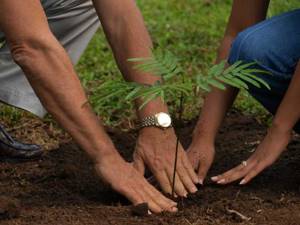
You may also be interested in an article about weeping conifer varieties.
Indicators affecting planting in autumn or spring
According to modern agricultural technology, in the autumn it is possible, and sometimes necessary, to plant almost any tree seedlings. The exception is seedlings that are overly sensitive due to species or vegetation characteristics. The category of such plants that need to be planted exclusively in spring includes heat-loving seedlings of fruit, berry, deciduous and coniferous trees that do not tolerate wintering well.
It is best to refrain from planting seedlings of peach, apricot, cherry, chestnut, walnut and some varieties of southern plum trees in the autumn. There is also no need to plant seedlings in late autumn that were brought from other climatic regions and have not yet gone through the wintering stage in the weather conditions expected for growing.
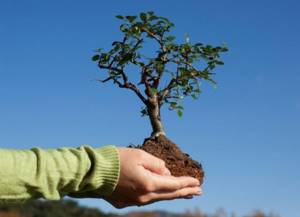
When choosing seedlings in the autumn, you can take a good look at the quality of the planting material, which will protect you from mistakes when purchasing fruit, deciduous or coniferous plants. The leaves, root system and degree of wood maturation are clearly visible on autumn planting material, which allows you to assess the health of the seedlings. Seedlings planted in autumn begin intensive growth and development with the onset of the first spring days.
The basic rules that should be followed if it is necessary to plant seedlings in the fall are the following:
- planting a seedling together with a high-quality earthen ball;
- there should not be a high level of groundwater near the house where the planting is expected;
- planting must be carried out at least three weeks before the onset of persistent and severe frosts.
Each of the owners of a country plot dreams of creating heavenly conditions for relaxation. At the same time, many factors will determine the degree of comfort, the most important being the presence of green spaces on the site. These can be ornamental shrubs and trees or an orchard. Naturally, the question arises: what trees to plant, because each species needs certain conditions for successful growth and development. In addition, there are popular beliefs that do not recommend planting certain types of plants in the area near the house.
Content:
- Choosing trees for a landscape garden taking into account the climate
- conifers
- birch
- Linden
- rowan video
- When to plant trees - in autumn or spring, advantages and disadvantages
- Recommended dates for planting trees in the fall video
- If the seedling has already been purchased, but it was not possible to plant it in the fall video
- How many trees to plant in the garden
- Some useful tips
Choosing trees for a landscape garden taking into account the climate
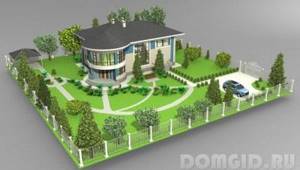
An important factor in the normal growth of trees is planting them in the appropriate climatic zones; for example, in the northern regions it is not recommended to plant heat-loving and frost-resistant ornamental and fruit trees; they can die in winter from low temperatures or icing. Plants brought from the North will also not feel comfortable in the arid southern regions.
Although there is no direct evidence that spruce and pine, walnut or birch trees planted near a house will bring misfortune to its owners, it is quite possible to assume that these trees can still create some practical problems. For example, a nut has a very developed root system, which, as it grows, can penetrate under the scrap and destroy its foundation or damage communications laid near buildings.
conifers
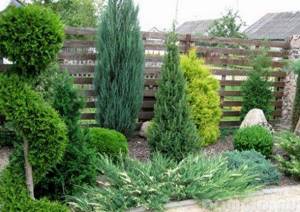
You should treat spruce and pine trees growing near your house with some caution - in fact, in the summer there is always a concentration of insects near them: mosquitoes and midges, which greatly annoy people. In the northern regions, it’s quite the opposite - people are happy to decorate their plots with coniferous trees and enjoy the fresh aroma of evergreen beauties exuding.
Phytoncides secreted by the plant:
- improve the functioning of the cardiovascular system,
- treat bronchial and pulmonary diseases,
- kill pathogens.
It should be taken into account that spruce grows quickly, its height can reach 50 m; it is also good that spruce is long-lived, it can grow up to 300 years. Spruce is planted on loamy or sandy loamy acidic soil.
birch

Birch trees should not be planted in a small area in dry areas - their root system is very strong and is capable of extracting all available moisture reserves from the soil - other plants will wither next to birches. If the desire to grow a birch tree has won, you will have to consider the possibility of frequent and abundant watering of the site (an adult tree can absorb up to 250 liters of water per day). The ideal option for the site would be to plant low trees, for example, Karelian ones; they look great next to conifers, maples and bird cherry, oak and rowan. The most suitable time for planting a tree is early spring.
Linden

It is quite unpretentious and can grow in a shaded place, but the soil must be well-drained. Usually, linden trees line alleys, but it also looks good as a single plant. Experienced gardeners are attracted by the opportunity to give a growing tree an original decorative shape. This is one of the trees that can bring real benefits to the site itself and improve the quality of the soil on it - humus from linden leaves enriches the soil with valuable minerals and increases its fertility. Linden is very beautiful during flowering, which usually begins in the 10th year of life.
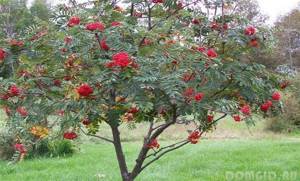
Rowan
There are also representatives of the flora that are recommended for planting on the site. These include the rowan - a tree that in ancient times was considered a talisman for the home, a symbol that gives prosperity and well-being. It has a rather decorative appearance, thanks to its bright leaves and clusters of berries. The condition for successful cultivation will be planting in a non-wetland area, in partial shade or in the sun. The tree makes a beautiful composition with conifers and deciduous trees, shrubs such as honeysuckle, rose hips and barberry.
When to plant trees - in autumn or spring, advantages and disadvantages
It is impossible to give an accurate and unambiguous recommendation on planting dates - the type of trees being planted, the conditions of a particular year, the condition of the soil, and the characteristics of the species should be taken into account.
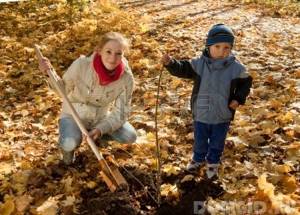
Agronomists believe that it is best to plant trees in the fall, at the end of September - October. The plants will have enough time to adapt; they will have time to take root before the onset of frost. In addition, when choosing seedlings in the fall, you can more clearly determine their condition and ensure the health of the bark, leaves, and root system. The establishment of warm weather in the spring will lead to their active development and growth.
Fruit trees such as apricot, walnut, peach, and cherry should be planted with caution in the fall - due to their heat-loving nature, they have difficulty surviving the winter. Seedlings brought from other natural areas are not recommended for autumn planting - their acclimatization occurs with complications.
- The main conditions for successful autumn tree planting:
- the seedling should be transferred to a new place together with a lump of earth,
- Planting should be done no less than a month before the onset of frost.
The following fruit trees are recommended for autumn planting:
- plums and cherry plums,
- apple and pear,
- rowan and mulberry.
As experienced gardeners note, the fruits of trees planted in the fall grow juicier and larger, but it is recommended to plant only those varieties that are resistant to frost.
Autumn planting of most varieties of coniferous trees will be more effective; they take root more easily. Recommended for autumn planting:
- hemlock and thuja,
- pine and spruce,
- juniper and larch.
Most species of ornamental trees, such as linden, poplar, maple, and ash, are also best planted in the fall. The special structure of the root system of oak and birch suggests their planting in the spring. The reason is the absence of branches on the tap root; spring planting allows the tree to quickly establish the process of providing nutrients and moisture.
Among the positive aspects of autumn planting, the following should be highlighted:
- the possibility of a wide selection of high-quality planting material with a well-formed root system,
- many sellers, as advertising, bring to the market fruits obtained from trees of different varieties; the opportunity to evaluate the appearance and taste of the fruits of a given variety is very important for novice gardeners,
- no need for numerous waterings after planting and special care, autumn rains will enrich the soil with moisture in sufficient quantities,
- before spring, the tree will be able to heal all the wounds inflicted during transplantation and acquire suction roots, because they will grow until the soil temperature drops to +4 C,
- the opportunity to save maximum time for performing spring work in the garden.
When deciding which trees can be planted in the fall, you should definitely take into account the frost resistance of the varieties chosen for planting.
Recommended dates for planting trees in autumn
Trees can be planted throughout almost the entire fall, of course, if the weather is warm enough. Autumn planting begins at the end of September and ends at the end of October; in the case of a very warm November, the timing can be slightly extended. For central Russia, acceptable periods are from mid-September to mid-October; in the northern regions they are shorter, in the southern regions they are longer.
In any case, the time limits are not fixed for any area; to a large extent they depend on the weather conditions of a particular year. The main guideline in this case should be the beginning of the period of biological rest, i.e. end of leaf fall.
If the seedling has already been purchased, but it was not possible to plant it in the fall
This situation occurs relatively often - either a seedling of the desired variety was purchased at the very end of the season, on sale, or the temperature dropped too sharply to below zero. You shouldn’t be too upset; there is a way out. You just have to save the seedling until spring.
There are several ways to store seedlings in winter:
- in a cool basement with high humidity,
- by snowing,
- digging into the ground.

For storage in a basement, you will need to ensure the air humidity in it is about 90% and the temperature is within 0 - +10 C. It is best to place the roots of the seedlings in an old bucket or bowl and fill it with peat. Peat will need to be watered infrequently - once every two weeks. This way the young trees will overwinter well.
A more risky method is snowing - the seedlings are well packed and buried deep in the snow. It is the thick layer of snow that will not allow the temperature to drop below the living level acceptable for the tree.

To properly bury seedlings, it is advisable to adhere to the following rules:
- you should choose a suitable place, protected from the wind, dig a ditch with an inclined wall on it,
- place seedlings in it, orient them from north to south, fill with soil up to half the trunk, carefully compact the embankment,
- ensure protection of trunks and branches from attacks by rodents,
- when frost sets in, fill the trees completely, forming a mound,
- It is not recommended to use any covering materials, especially polyethylene film - in the spring, with the onset of heat, the seedlings may trample.
How many trees to plant in the garden

Of course, the number of plants that can be planted on a plot is determined by the size of the plot itself and the dimensions of an adult tree. When creating a landscape project, the number and species of trees for planting are provided. But what to do with fruit trees? If the space for the garden is large enough, then the number of trees should be carefully calculated; a reasonable approach to solving the issue will help at least partially switch to home-grown products, and therefore will allow you to save money.
The standard set of trees planted in the garden should include the following trees.
Apple trees . There is no point in giving preference exclusively to summer varieties, especially if there is space to store the crop in the winter. In summer, apples have a fairly low price; buying a bucket or two for canning is not particularly expensive; it is much more important to get a good harvest of winter varieties intended for long-term storage - in winter, the cost of quality apples of good varieties is quite high. Hence, we can recommend planting summer, autumn and winter apple trees in the following proportion: for each tree of a summer variety, plant 2 trees of autumn varieties and 3 of winter varieties. If there is no basement, then winter apple trees should be planted about half as many - in room conditions, apples will have a shorter shelf life. For a small family of 3-5 people, it will be enough to plant a couple of apple trees of summer varieties with different ripening periods, 3-4 trees of autumn varieties, 5-6 trees of winter varieties.
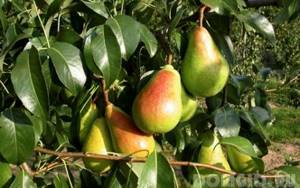
Pears. It is advisable to plant two of them, this will improve the pollination of the trees, which will help increase productivity. Again, you should pay attention to both the summer variety and the autumn-winter variety.
Cherries and cherries . It is also recommended to plant a couple of trees of each type.
Cherry plums and cherry plums . It will be enough to plant 2 trees of different ripening varieties.
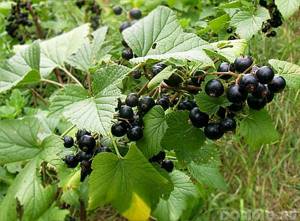
Currants and gooseberries. It is necessary to plant several currant bushes in a row, otherwise there will be no harvest. You can store currants frozen and grated with sugar. By stocking up on berries, you can provide the whole family with a delicious vitamin product all year round. It is better to choose gooseberry varieties that are thornless and resistant to all kinds of diseases.
Don't forget about raspberries and blackberries . It is better to plant remontant varieties, but their ripening period should end before the onset of frost.

Honeysuckle . This shrub makes it possible to get the earliest berries. It is advisable to plant at least two bushes of different varieties.
Of course, the indicated number of plants in the garden is approximate; each garden owner can adjust it depending on his preferences.
Some useful tips
- Experience shows that for planting in the middle zone, in the Urals and Siberia, it is best to choose zoned or winter-hardy varieties; they are adapted to survive in harsh climatic conditions. In these natural zones, pears, apple trees, and mulberries selected in Siberia and the Urals grow and bear fruit well.
- For the southern regions, the autumn option of planting trees is more acceptable - a humid, warm autumn lasts a long time, creating excellent conditions for seedlings to take root; spring often changes into an early, too hot summer.
- If seedlings are dug up too early, their young shoots will remain immature, which significantly increases the risk of frostbite.
- You should not purchase beautiful seedlings with leaves that have not fallen - such specimens are usually unripe and overdried, because most of the moisture received by the plant is lost through the leaf plate.
We should not forget that nature will always help its seedling offspring to cope with all problems and survive; the gardener’s task is to promptly provide her with healthy, mature trees with a strong root system. If you know how to plant a tree correctly, it will grow quickly, regardless of when exactly it is planted, and will delight us with lush greenery and bright fruits.
Author: Sergey and Svetlana Khudentsov
10
Rules and terms of autumn planting
There are a number of rules, the implementation of which guarantees good survival of plants planted in the autumn.

- Immediately before planting, you should tear off all the remaining leaves on the seedling. The rule is observed if the planting material is fresh and the foliage is not yet dry.
- The standard part of the seedling must be smooth and undamaged, and the crown of the tree must have established buds and prominent main branches.
- When digging a planting hole, the top soil layer should be removed and placed in one pile, and the lower and deep-lying soil layers should be piled in the other direction.
- The depth of the planting hole should be such that when the seedling is immersed in it, the root collar rises 5 centimeters above the ground surface.
- The width of the planting hole should be twice as large as the diameter of the seedling's root system.
- The removed top soil should be mixed with humus at the rate of one bucket for each seedling.
- Superphosphate and potassium chloride should be added to the planting pit, which will ensure good survival rate for the plant. If it is impossible to use such fertilizers, they can easily be replaced with ordinary wood ash.
- On top of the fertilizer, it is necessary to fill two-thirds of the hole with a mixture of soil and humus and install a special peg.
- The seedling placed in the hole should be leveled as much as possible, the root system should be distributed and covered with the remaining soil.
- At the final stage, the root system of the plant is sprinkled with earth, and then with peat and sawdust.
Mistakes when planting fruit tree seedlings (video)
To fix the planted plant in the hole, you should softly tie the stem part to the peg installed in the hole. The ground around the stem should be carefully but very gently trampled down.
We also recommend that you read the article about ways to protect your garden from winter frosts.
Planting trees in autumn is not only convenient, but also rational. In the spring, the seedlings will already begin active growth, and gardeners will have more time to carry out all the necessary spring work on the site.
